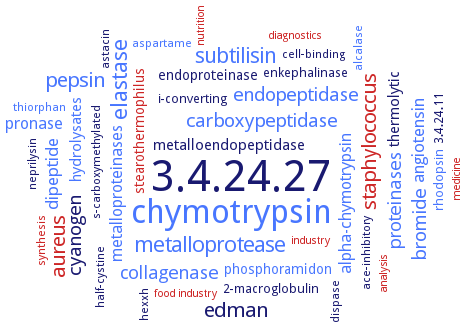3.4.24.27: thermolysin
This is an abbreviated version!
For detailed information about thermolysin, go to the full flat file.

Word Map on EC 3.4.24.27 
-
3.4.24.27
-
chymotrypsin
-
elastase
-
metalloprotease
-
subtilisin
-
staphylococcus
-
edman
-
pepsin
-
aureus
-
carboxypeptidase
-
endopeptidase
-
bromide
-
cyanogen
-
collagenase
-
proteinases
-
dipeptide
-
angiotensin
-
pronase
-
metalloproteinases
-
alpha-chymotrypsin
-
thermolytic
-
hydrolysates
-
metalloendopeptidase
-
stearothermophilus
-
endoproteinase
-
phosphoramidon
-
i-converting
-
enkephalinase
-
rhodopsin
-
2-macroglobulin
-
3.4.24.11
-
cell-binding
-
alcalase
-
ace-inhibitory
-
hexxh
-
dispase
-
aspartame
-
thiorphan
-
neprilysin
-
s-carboxymethylated
-
half-cystine
-
astacin
-
synthesis
-
industry
-
nutrition
-
food industry
-
diagnostics
-
medicine
-
analysis
- 3.4.24.27
- chymotrypsin
- elastase
- metalloprotease
- subtilisin
- staphylococcus
-
edman
- pepsin
- aureus
- carboxypeptidase
- endopeptidase
- bromide
-
cyanogen
- collagenase
- proteinases
- dipeptide
- angiotensin
- pronase
- metalloproteinases
- alpha-chymotrypsin
-
thermolytic
- hydrolysates
- metalloendopeptidase
- stearothermophilus
-
endoproteinase
- phosphoramidon
-
i-converting
- enkephalinase
- rhodopsin
-
2-macroglobulin
-
3.4.24.11
-
cell-binding
- alcalase
-
ace-inhibitory
-
hexxh
-
dispase
- aspartame
- thiorphan
- neprilysin
-
s-carboxymethylated
-
half-cystine
- astacin
- synthesis
- industry
- nutrition
- food industry
- diagnostics
- medicine
- analysis
Reaction
preferential cleavage: -/-Leu > -/-Phe =
Synonyms
Bacillus thermoproteolyticus neutral proteinase, EC 3.4.24.4, hspA, LIC13322, Neutral metalloproteinase, NprM, protease type X, proteinase type X, Proteinase, Bacillus thermoproteolyticus neutral, protex 14L, Thermoase, thermoase PC10F, Thermoase Y10, thermolysin, thermolysin-like protease, Thermostable neutral proteinase, TL, TLN, TLP, TLP-ste
ECTree
Advanced search results
General Stability
General Stability on EC 3.4.24.27 - thermolysin
Please wait a moment until all data is loaded. This message will disappear when all data is loaded.
After precipitation with trichloroacetic acid the purified enzyme irreversibly loses activity and solubility at neutral pH
-
important role of Asn116 in the activity and stability of thermolysin presumably by stabilizing the beta-hairpin structure. In the N-terminal domain of thermolysin, two antiparallel beta-strands, Asn112-Ala113-Phe114-Trp115 and Ser118-Gln119-Met120-Val121-Tyr122 are connected by an Asn116-Gly117 turn to form a beta-hairpin structure


 results (
results ( results (
results ( top
top





